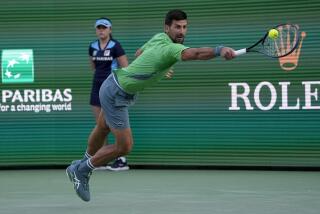No More Oasis From Price Hikes for Desert Tennis
INDIAN WELLS â Your name is Steve Simon, you are the chief operating officer of the prestigious Indian Wells tennis event and you are bracing for a storm.
You are raising ticket prices for 2003, some as much as 40%.
Yes, this is a rich manâs playground, a marquee event in a resort playground where the stress decision of the day frequently is what number sunscreen to use.
But is anybody this rich? Can anybody not named Gates or Anschutz keep affording the leisurely afternoons and warm nights watching young people pound tennis balls at each other?
Simon, a soft-spoken force behind much of the success of Charlie Pasarellâs vision for the ultimate tennis tournament destination spot, thinks the market will endure this.
âWe agonize over these things,â Simon said here Wednesday, in a lengthy interview with him and DeeDee Felich, tournament assistant director. âThere is no real formula. We watch it, monitor what the rest of the industry is doing. We donât know what the ceiling is.â
Clearly, Indian Wells officials do not think the 2003 prices they have set will reach it.
One of Simonâs problems is the sudden sticker shock. Even though he, Tournament Director Pasarell and Felich did the most fan-friendly thing they could three years ago, when they moved from the Hyatt Grand Champions Stadium a mile or so down the street to their new state-of-the-art tennis palace that rises up out of the desert sand like some Taj Mahal, they now must call in those markers.
Three years ago, their deal with their main ticket buyers, the box-holders who moved with them from the Hyatt to the new stadium, was that their prices would be frozen through this yearâs tournament. That meant that a Stadium box--one ticket for all 17 days of the event--that went for $800 in 2000 went for $800 in 2002; a courtside box was frozen at $850, a front-row box at $900 and a club seat ticket (a suite-level area where food and other amenities are right there) at $1,250.
People buying in along the way have paid elevated prices, but those who got in after the â99 tournament and stayed in have had no increase.
But the three-year deal is up.
Starting next year, the $800 stadium box seat becomes $1,110, a 27% increase; the $850 courtside boxes become $1,300, a 35% increase; the $900 front-row boxes become $1,500, a 40% increase, and the $1,250 club suite seats become $1,800, a 30% increase.
Suffice to say that discussions of that are buzzing about the stadium these days. The ticket buyers were told up front that this time would come, but now that it has, there are some unhappy campers sitting around in their Filas.
Simonâs position is made even more difficult by the current shaky state of tennis and the current events of this week.
Its womenâs tour seems to have a new CEO about every six months and went for nearly a year without a title sponsor. The menâs tour, a smash success a few summers ago, got involved in a disastrous deal with a marketing group called ISL. ISL is long gone and the Indian Wells event scrambled like Fran Tarkenton to come up with newcomer Pacific Life as a sponsor this year.
And then, the Indian Wells event ran into tough sledding on its womenâs side, especially costly because the women, led by Venus and Serena Williams, have frequently been a bigger draw in recent years. In a controversial moment last year, Venus defaulted to Serena in a semifinal, just moments before they were to play, with a full stadium and ESPN minutes away from going on the air. The next day, the crowd, suspecting an arrangement had more to do with the default than an injury, booed Serena as she took the court for the final, and kept booing her for most of her match, which she won. This year, the Williams sisters, citing the harsh treatment they received from the rowdies in the desert, said they wouldnât play here.
Some reports had them saying they would never come back here, but âneverâ with the Williams sisters and father Richard can last as long as six months.
Then it got worse, or as Simon dryly put it, âWe hit a bit of a fluke.â
Two other top 10 players, , Jennifer Capriati and Amelie Mauresmo, decided not to play here and Southern Californiaâs own Lindsay Davenport, also in the top 10, is injured. That meant that half of the womenâs top 10 wasnât here, unheard of for a womenâs event with a $2.1-million purse.
There was additional irony in all this, something that probably only happens in the oft-messed up world of tennis. The Williams sisters, as well as Capriati, are managed by IMG, which also is a main partner in the Indian Wells tournament.
On top of this, a worn-down superstar, Andre Agassi, lost in the first round on the menâs side; the best-hope newcomer, Andy Roddick, got sick and defaulted, and this became the Pete Sampras Invitational.
Against this backdrop, Simon is trying to sell.
âWeâre like any other business.â Simon said. âThere are things we need to do.â
The nut he has to crack includes enough sponsorship to cover not only the womenâs $2.1-million purse, but the menâs $2.45 million. Also, whatever debt service you have with a $74-million stadium whose main revenue producer is a once-a-year, 17-day event.
Yet things are going well. Felich said that traffic at the ticket renewal has much more activity than last year and that this yearâs tournament, while paid attendance is fairly flat compared to last year at this stage, is faring much better in revenue because more of the people who have purchased tickets are actually coming to the event and buying hot dogs and T-shirts.
Simon and Felich also hope that the message of comparative prices gets to their customers. The tournament most similar to theirs, Key Biscayneâs upcoming two-week event, is more expensive. Its front-row boxes are now $1,120, or $220 higher than here. And the U.S. Open, an incredible cash cow for the U.S. Tennis Assn., would get $11,375 for its front boxes.
Also, the high seats above the boxes here will remain in the affordable range of $25-$50, with lots of discounts easily available.
Still, the public--even the tennis public--has a breaking point somewhere near the back of their wallets. Indian Wells officials hope they havenât gotten there yet.
More to Read
Sign up for The Wild
Weâll help you find the best places to hike, bike and run, as well as the perfect silent spots for meditation and yoga.
You may occasionally receive promotional content from the Los Angeles Times.







